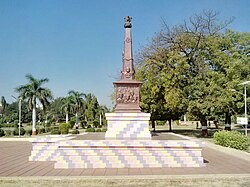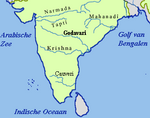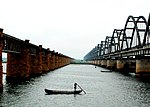Parbhani district
Parbhani district | |
|---|---|
 Memorial to freedom fighters from Marathwada in Parbhani city | |
| Nickname: Land of saints | |
 Location in Maharashtra | |
| Coordinates (Parbhani): 19°30′N 76°45′E / 19.500°N 76.750°E | |
| Country | |
| State | Maharashtra |
| Division | Aurangabad |
| Headquarters | Parbhani |
| Tehsils | 1. Parbhani, 2. Gangakhed, 3. Sonpeth, 4. Pathri, 5. Manwath, 6. Palam, 7. Sailu, 8. Jintur, 9. Purna |
| Government | |
| • Body | Parbhani Zilla Parishad |
| • Guardian Minister | Sanjay Bansode (Cabinet Minister) |
| • President Z. P. Parbhani | NA |
| • District Collector | Mr. D. M. Mugalikar IAS |
| • CEO Z. P. Parbhani | NA |
| • MPs | Sanjay Haribhau Jadhav (Parbhani) |
| Area | |
| • Total | 6,251 km2 (2,414 sq mi) |
| Population (2011) | |
| • Total | 1,636,086[1] |
| Demonym | Parbhanikar |
| Demographics | |
| • Literacy | 75.22% |
| • Sex ratio | 940 |
| Time zone | UTC+05:30 (IST) |
| Major highways | NH 222[2] |
| Website | parbhani |

Parbhani district (Marathi pronunciation: [pəɾbʰəɳiː] ) is one of the eight districts in the Marathawada region of Maharashtra state of India. Parbhani city is the headquarters of this district. Parbhani district is well known for the Marathwada rebellion and religious tourism of Hinduism, Jainism.
Officer
[edit]Members of Parliament
[edit]Sanjay Jadhav
Members of Legislative assembly
[edit]- Meghana Bordikar (BJP) (Jintur)
- Rahul Patil(SHS(UBT)) (Parbhani)
- Ratnakar Gutte(RSP) (Gangakhed)
- Suresh Warpudkar(INC) (Pathri)
Guardian Minister
[edit]| Guardian Minister Parbhani | |
|---|---|
| पालकमंत्री परभणी | |
 Emblem of India | |
since 04 October 2023 | |
| Style | The Honourable |
| Residence | Parbhani |
| Appointer | Chief Minister of Maharashtra |
| Term length | 5 years / No time limit |
| Website | parbhani |
list of Guardian Minister
[edit]| Name | Term of office |
|---|---|
| Diwakar Raote Cabinet Minister |
31 October 2014 - 8 November 2019 |
| Nawab Malik Cabinet Minister |
9 January 2020 - 27 March 2022 |
| Dhananjay Munde Cabinet Minister Additional Charge |
27 March 2022 - 29 June 2022 |
| Tanaji Sawant Cabinet Minister |
24 September 2022 - 4 October 2023 |
| Sanjay Bansode Cabinet Minister |
4 October 2023 - Incumbent |
District Magistrate/Collector
[edit]| District Magistrate / Collector Parbhani | |
|---|---|
| जिल्हाधिकारी तथा जिल्हदंडाधिकरी परभणी | |
 Emblem of India | |
Incumbent since 2023Mr. Raghunath Gawade (IAS) | |
| Residence | At Parbhani District |
| Appointer | Government of Maharashtra |
| Term length | No time limit |
| Website | parbhani |
list of District Magistrate / Collector
[edit]| Name | Term of office |
|---|---|
| Mr Raghunath Gawade (IAS) | 2023 - Incumbent |
History
[edit]From 1596 to 1724, major part of the present territory of the district was divided between Pathri and Washim sarkars of Berar Subah of the Mughal empire. In 1724, after the battle of Sakharkheda, it went under the Nizam's rule. Following the re-organization of the states in 1956, Parbhani along with the other districts of Marathwada became part of Bombay State. On 1 May 1960 when Maharashtra state was formed, it became a part of it.[3]
Geography
[edit]Parbhani district lies between 18.45 and 20.10 North Latitudes and 76.13 and 77.39 East Longitude. The district is bounded on the north by Hingoli and Buldhana districts. On the east by Nanded and Hingoli, on the South by Latur and on the West by Beed and Jalna districts.
The hills on the north east form part of the Ajanta Hill ranges which passes through Jintur Tahsil. The hills on the southern side are the Balaghat Hill ranges. The district is at an average height of 357 m from mean sea level.
Climate
[edit]Parbhani's climate is classified as tropical. The Köppen-Geiger climate classification is Aw. When compared with winter, the summers have much more rainfall.[4]
| Climate data for Parbhani (1961–1990) | |||||||||||||
|---|---|---|---|---|---|---|---|---|---|---|---|---|---|
| Month | Jan | Feb | Mar | Apr | May | Jun | Jul | Aug | Sep | Oct | Nov | Dec | Year |
| Record high °C (°F) | 36.0 (96.8) |
38.2 (100.8) |
41.1 (106.0) |
44.5 (112.1) |
45.0 (113.0) |
44.2 (111.6) |
38.1 (100.6) |
35.0 (95.0) |
36.1 (97.0) |
36.1 (97.0) |
35.0 (95.0) |
34.0 (93.2) |
38.4 (101.1) |
| Mean daily maximum °C (°F) | 28.0 (82.4) |
32.0 (89.6) |
35.6 (96.1) |
38.4 (101.1) |
39.6 (103.3) |
33.0 (91.4) |
30.1 (86.2) |
29.4 (84.9) |
30.7 (87.3) |
31.6 (88.9) |
30.0 (86.0) |
28.0 (82.4) |
32.3 (90.1) |
| Mean daily minimum °C (°F) | 11.8 (53.2) |
14.9 (58.8) |
18.7 (65.7) |
22.3 (72.1) |
24.6 (76.3) |
24.0 (75.2) |
22.8 (73.0) |
22.2 (72.0) |
21.8 (71.2) |
19.0 (66.2) |
14.7 (58.5) |
11.5 (52.7) |
18.9 (66.0) |
| Record low °C (°F) | 3.0 (37.4) |
5.9 (42.6) |
9.6 (49.3) |
14.8 (58.6) |
17.1 (62.8) |
18.2 (64.8) |
17.9 (64.2) |
18.1 (64.6) |
15.0 (59.0) |
9.1 (48.4) |
6.8 (44.2) |
2.7 (36.9) |
2.7 (36.9) |
| Average precipitation mm (inches) | 5.7 (0.22) |
4.6 (0.18) |
12.5 (0.49) |
7.0 (0.28) |
19.2 (0.76) |
157.8 (6.21) |
238.4 (9.39) |
265.4 (10.45) |
184.9 (7.28) |
74.6 (2.94) |
13.8 (0.54) |
12.5 (0.49) |
996.4 (39.23) |
| Average rainy days | 0.4 | 0.4 | 0.8 | 0.8 | 1.8 | 8.8 | 10.8 | 11.2 | 8.9 | 3.2 | 0.8 | 0.7 | 48.6 |
| Source: India Meteorological Department (record high and low up to 2010)[5][6] | |||||||||||||
This entire Marathwada region, a district geographical region, was a part of Hyderabad State. After reorganization of states in 1956 it became a part of the then Bombay state and from 1960 onwards it is part of the present Maharashtra state.
The state capital of Mumbai is to the west; Parbhani is well connected by road to other major towns in Maharashtra and also in the neighboring state of Telangana. Parbhani is a major railway junction connecting Telangana with Marathwada.
In the northeast, on the boundary of Parbhani and Hingoli districts there is extension of Ajanta ranges called Nirmal Hills. The main river in the district is Godavari River, other rivers are Purna and Dudhana which are tributaries of Godavari. Major dams in Parbhani district are Yeldari dam which is on Purna River, Lower Dudhana dam is on Dudhana river, Mudgal barrage on Godavari River, Masoli Dam on Masoli River, and Karpara Dam on Karpara River.
Administrative Divisions
[edit]Parbhani district covers an area of about 6250.58 km2. The district is divided into 9 administrative Sub-units (Tehsils), namely, Parbhani, Gangakhed, Sonpeth, Pathri, Manwath, Palam, Selu, Jintur, and Purna.
Demographics
[edit]| Year | Pop. | ±% p.a. |
|---|---|---|
| 1901 | 353,265 | — |
| 1911 | 425,672 | +1.88% |
| 1921 | 418,191 | −0.18% |
| 1931 | 466,278 | +1.09% |
| 1941 | 498,103 | +0.66% |
| 1951 | 550,621 | +1.01% |
| 1961 | 641,081 | +1.53% |
| 1971 | 805,383 | +2.31% |
| 1981 | 987,411 | +2.06% |
| 1991 | 1,293,104 | +2.73% |
| 2001 | 1,527,715 | +1.68% |
| 2011 | 1,836,086 | +1.86% |
| source:[7] | ||
According to the 2011 census Parbhani district has a population of 1,836,086,[8] roughly equal to the nation of Kosovo[9] or the US state of Nebraska.[10] This gives it a ranking of 259th in India (out of a total of 640).[8] The district has a population density of 295 inhabitants per square kilometre (760/sq mi) .[8] Its population growth rate over the decade 2001-2011 was 20.18%.[8] Parbhani has a sex ratio of 940 females for every 1000 males,[8] and a literacy rate of 75.22%. 31.03% of the population live in urban areas. Scheduled Castes and Scheduled Tribes make up 13.47% and 2.21% of the population respectively.[8]
Religion
[edit]Hindus and Buddhists make up the majority of the population, both concentrated in rural areas. Ministry of Minority Affairs declared Parbhani as Minority Concentration District as Muslims makes 15.97% of the population.[12] Muslims are concentrated in urban areas and make up the majority in Jintur and Pathri.[11]
Languages
[edit]At the time of the 2011 Census of India, 78.35% of the population in the district spoke Marathi, 11.97% Urdu, 4.99% Hindi and 3.06% Lambadi as their first language.[13]
Languages used mostly in the district include Marathi, Dakkhani (Deccan) Urdu, Andh, Lambadi and Hindi.[14]
Land of saints
[edit]Parbhani has been described as the land of saints, as several saints have been associated with Parbhani including Janabai from Gangakhed. The famous mathematician Bhaskarbhatt was from Bori in Parbhani district.
Nemgiri (sequence of caves) related to Jainism, is situated in Jintur town of the district.[15]
Sri Sai Janmasthan Temple (Sai Baba Birth Temple) is a temple in heart of the Pathri town, where spiritual master Sai Baba of Shirdi was born.[16][17]
Selu town was home to Guru of Shri Sai Baba "Shri Babasaheb Maharaj". Sai Baba stayed with him for 12 years during which time he acquired knowledge from his Guru.
Turabul Haq Dargah, the tomb of the eponymous Muslim saint is located in Parbhani city.
Mudgaleshwar
[edit]It is located on the bank of the Godavari river. A temple is in the midst of the river. The temple in the middle of the river flow and is more than nine hundred years old and same is written on stone script at the entrance. Temple on river bank and old ghat was built by "Ahilya Bai" 250 years back. Lord "Narasimha Swamy" has taken the form "Shivalinga" along with his wife "Mahalaxmi" and son "Moudgalya" and daughter-in-law "Jaabalabai". During rainy season the temple gets immersed in water. To have darshan one has to swim to the temple. Best time to visit is summer season i.e. from April to June. To reach the place one has to travel by train via "Parbhani" or "Parli Vaidyanath".
The temple used to be managed by Shri Sahebrao Mudgalkar and Shri Subhashrao Mudgalkar. The Shivaratri is celebrated here every year. All type of pujas are performed here. Nagbali and Sukhshanti pujas are very famous.
The new dam is constructed on the river. Recently a Dattatriya temple is constructed and murthy staphana is completed on 26 December 2012.
See also
[edit]References
[edit]- ^ "Parbhani District : Census 2011 data". Retrieved 9 October 2012.
- ^ "NH 222". Wikimapia. Retrieved 12 May 2015.
- ^ "Chapter 2-History". Parbhani District Gazetteers, Government of Maharashtra. 1967.
- ^ "Climate Parbhani: Temperature, Climate graph, Climate table for Parbhani". En.climate-data.org. Retrieved 18 April 2017.
- ^ "Parbhani Climatological Table Period: 1961–1990". India Meteorological Department. Archived from the original on 14 April 2015. Retrieved 10 April 2015.
- ^ "Ever recorded Maximum and minimum temperatures up to 2010" (PDF). India Meteorological Department. Archived from the original (PDF) on 16 March 2014. Retrieved 10 April 2015.
- ^ Decadal Variation In Population Since 1901
- ^ a b c d e f "District Census Hand Book – Parbhani" (PDF). Census of India. Registrar General and Census Commissioner of India.
- ^ US Directorate of Intelligence. "Country Comparison:Population". Archived from the original on 13 June 2007. Retrieved 1 October 2011.
Kosovo 1,825,632 July 2011 est.
- ^ "2010 Resident Population Data". U. S. Census Bureau. Retrieved 30 September 2011.
Nebraska 1,826,341
- ^ a b "Population by Religion - Maharashtra". censusindia.gov.in. Registrar General and Census Commissioner of India. 2011.
- ^ "Parbhani |". Minorityaffairs.gov.in. Retrieved 29 May 2015.
- ^ a b "Table C-16 Population by Mother Tongue: Maharashtra". censusindia.gov.in. Registrar General and Census Commissioner of India.
- ^ M. Paul Lewis, ed. (2009). "Andh: A language of India". Ethnologue: Languages of the World (16th ed.). Dallas, Texas: SIL International. Retrieved 28 September 2011.
- ^ "Nemgiri.org". nemgiri.org. Retrieved 26 August 2016.
- ^ "Sri Shirdi Sai Baba Birthplace - Sai Janmasthan". Saijanmasthanpathri.com. Retrieved 12 April 2022.
- ^ "Sai Baba was not a Muslim but a Brahmin, penalise those who insult him: Temple trust to HC". The Indian Express. 15 September 2014. Retrieved 1 August 2015.





